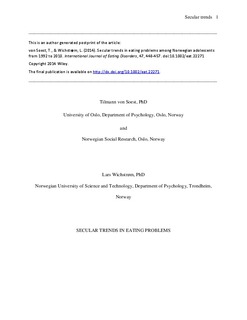| dc.description.abstract | Objective
This study examines secular trends in eating problems among adolescents between 1992 and 2010. The study aims further to investigate whether such trends can be accounted for by secular changes in putative risk factors.
Method
Three nationwide surveys of Norwegian senior high-school students were conducted in 1992, 2002, and 2010 (response rates 97.0, 91.0, and 83.2%). At each time point, approximately 3,000 adolescents participated. Eating problems were assessed by means of the Dieting and the Bulimia and Food Preoccupation subscales of the Eating Attitude Test-12. Moreover, a variety of potential risk factors that might account for time trends in such problems were measured.
Results
Dieting scores increased almost linearly for both genders during the research period. No differences over time in Bulimia and Food Preoccupation scores were seen among boys, whereas these symptoms peaked in 2002 for girls with considerably lower levels in both 1992 and 2010. The increase in Dieting from 1992 to 2010 for both genders could be attributed in part to increasing body mass index levels and, to a lesser degree, to depressive symptoms among females. The girls' time trend in Bulimia and Food Preoccupation was to some extent related to changes in appearance satisfaction, alcohol intoxication, and global self-worth.
Discussion
This study is one of few to statistically examine how secular trends in eating problems are related to changes in putative risk factors. The study does not however provide conclusive information on the causal direction between putative risk factors and eating problems. © 2014 Wiley Periodicals, Inc. (Int J Eat Disord 2014; 47:448–457) | nb_NO |
